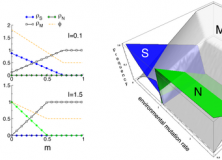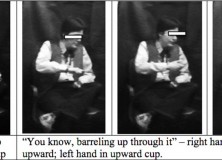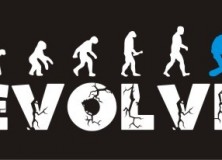Following on from the Baronchelli et al paper a couple of months ago, PLOS ONE has published “Evolution in a Changing Environment” by the same authors. The conclusions of the 2 papers both argue that if language is rapidly changing (and it is), then generalist, neutral genes, rather than specialist ones, are advantageous. This argues that language is likely more the result of general cognitive abilities as language change happens so rapidly. In contrast to the last paper though, this one focuses much less on (specifically) linguistic change, and features a super sexy stochastic interacting particle model (if you’re into that sort of thing).
Abstract:
We propose a simple model for genetic adaptation to a changing environment, describing a fitness landscape characterized by two maxima. One is associated with “specialist” individuals that are adapted to the environment; this maximum moves over time as the environment changes. The other maximum is static, and represents “generalist” individuals not affected by environmental changes. The rest of the landscape is occupied by “maladapted” individuals. Our analysis considers the evolution of these three subpopulations. Our main result is that, in presence of a sufficiently stable environmental feature, as in the case of an unchanging aspect of a physical habitat, specialists can dominate the population. By contrast, rapidly changing environmental features, such as language or cultural habits, are a moving target for the genes; here, generalists dominate, because the best evolutionary strategy is to adopt neutral alleles not specialized for any specific environment. The model we propose is based on simple assumptions about evolutionary dynamics and describes all possible scenarios in a non-trivial phase diagram. The approach provides a general framework to address such fundamental issues as the Baldwin effect, the biological basis for language, or the ecological consequences of a rapid climate change.











